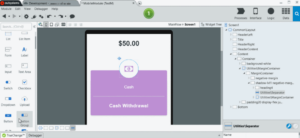
Building software without writing or writing minimal code is not a new concept. Influential benchmark products emerged in the early development of enterprise software in the 1980s and 1990s. For example, Microsoft introduced Access database application in its Office suite in 1992, and FileMaker, which was once acquired by Apple, was launched in 1985. Both of these applications are still operational today.
Early low-code development tools were limited to running in standalone or local area network environments, mainly targeting enterprise IT professionals to help establish business databases with high flexibility requirements, achieving typical CRUD (Create, Read, Update, Delete) application scenarios. Many proficient users of Access are not software developers; they can independently design and publish business data tables, enabling departments to share a database.
True application platform products emerged at the turn of the century. The well-known American financial software vendor Intuit introduced QuickBase in 1999, which, as the name suggests, is for rapidly building database applications. This product remained relatively unnoticed for a long time until it was spun off into an independent company in 2016. However, it did pioneer a new way of software implementation, allowing applications to run on encapsulated platforms without the need for code compilation and distribution. This was a crucial step in freeing up user productivity and expanding user base, as the number of enterprises and users with full control over software development and deployment capabilities is very limited. Therefore, this category has been referred to as APaaS (Application Platform as a Service) in recent years.
With the development of cloud computing technology, this category has revived. Building cloud-native applications has become simpler and more direct, and all applications built on APaaS are obviously serverless. It even blurs the boundary between development and usage, where users are developers, and developers can also be direct users. In 2014, the market research company Forrester officially introduced the concept of Low-Code and referred to the related category as Low-Code Application Platform (LCAP). Gartner subsequently named this category as high-productivity application platform as a service (hpaPaaS). In recent years, the entire industry has focused on the term “APaaS” when defining the category of no-code/low-code platforms.
During the development of this category, two basic technological paths naturally evolved.
Rapid Development Platforms based on IDE Frameworks
This technological path fully visualizes traditional Integrated Development Environments (IDEs), allowing developers to use configuration panels and consoles instead of writing a considerable amount of code. Developers can freely define frontend interface components, data source binding methods, data models, business logic, workflows, etc., and the system generates corresponding source code automatically, which developers can further modify if needed. Typical products on this path are Outsystems from the United States and Bettyblocks from Europe, both of which are leading in their respective markets.

The development environment interface of OutSystems
IDE mode application platforms can provide higher flexibility, especially in terms of autonomous control over the frontend interface. However, it still involves complex application development process management and relies heavily on technical languages. The generated applications still need to be compiled, deployed, and distributed. Therefore, it is mainly aimed at IT professionals, and it may even require a certain level of coding foundation, with a relatively long learning curve. Its main value lies in improving developer productivity and reducing repetitive labor. Strictly speaking, platforms that generate code and compile it into runnable applications cannot be called application platforms but rather development platforms.
Model-Driven Application Platforms
In the application platform market, another technological branch has become the new mainstream choice in recent years. It further reduces the workload of code development, and even achieves complete no-code, allowing business users to directly participate in or complete application implementation.
Model-driven is relative to code generation and compilation processes. Once users have constructed data models, view forms, permission roles, etc., visually on the application platform, the application runs directly in the runtime environment provided by the platform, without the need for separate compilation and distribution. In the SaaS form of application platform, applications can be built and used directly after user registration, without the need to configure separate application runtime environments.
By abandoning traditional DevOps processes, model-driven application platforms exponentially improve implementation efficiency and greatly expand the user base. However, it also has to sacrifice the freedom of application implementation. Users cannot design frontend interfaces as freely, and there are certain limitations on the complexity of backend logic. That being said, most enterprise software, especially CRUD applications, have relatively fixed interaction paradigms.
Airtable, Smartsheet, Zoho Creator, Monday.com, and our own Nocoly HAP are application platforms based on the model-driven technology route. These products are closer to end-user applications rather than development tools.

Nocoly HAP’s Application Interface
Integrated Design
Although application platforms generally follow two distinctly different technological paths, specific products may complement each other’s strengths. For IDE-mode application platforms, they may also provide pre-set templates to visualize data model designs, reducing the learning curve for users. For model-driven application platforms, they may also introduce low-code capabilities, allowing users to enhance flexibility with scripting languages, expressions, and functions. It can be said that the competition in this category is a balance between product capabilities and usability. No matter how powerful an application platform is, it cannot surpass native development mode, and even the simplest and most user-friendly platform will lack competitiveness if it cannot meet user needs.
Compared with the early products more than 20 years ago, the main progress of modern application platforms lies in:
- Integration with cloud computing environments, allowing users to directly access cloud-native capabilities at a very low cost.
- Advancements in web application technology frameworks, enabling browsers to support complex frontend interaction requirements.
- Integration with mobile technologies, enabling users to directly generate cross-platform mobile applications.
- Improvement in interaction design for complex logic, making it possible for visual configuration to implement complex application logic.
- Richer supportive technology frameworks, including databases, caching, object storage services, search engines, container technologies, and operational orchestration automation, enabling application platforms to provide performance identical to native application development.
In the foreseeable near future, application platforms will certainly replace a considerable proportion of native code development, significantly improving the productivity of the enterprise software industry. Market expectations regarding user experience and logic implementation will soon be better met.

